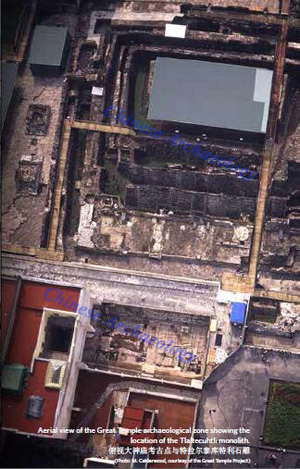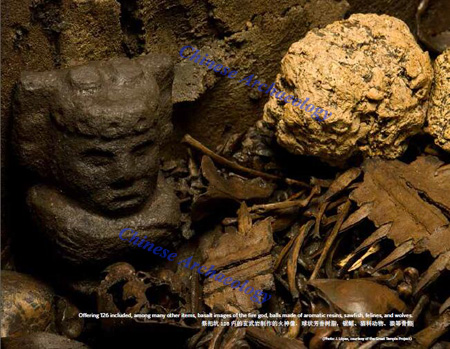The Great Temple Project: in Search of the Sacred Precinct of Mexico-Tenochtitlan
From:Chinese Archaeology NetWriter:Leonardo López LujDate:2015-12-28
The archaeology of Mexico-Tenochtitlan occupies a very unique place in the field of Mesoamerican studies. Constrained by its circumstances, it faces the same kind of challenges as archaeology in Rome, Jerusalem, Istanbul, Alexandria, and other settlements of the ancient world whose remains lie buried beneath a modern metropolis. In order to study the Mexica (Aztec) imperial capital, one must overcome the enormous obstacles presented by Mexico City, one of the largest demographic concentrations on our planet in the twenty-first century. The problem is compounded every day as the growth rate of the urban area increases at a dizzying pace. Thus Mexico-Tenochtitlan, along with its contemporaneous surrounding lakeside communities, has been buried nearly irretrievably under tons of asphalt and concrete.The fundamental problem, however, does not stem from the disproportionate expansion of the current city limits, but rather from the particularities of the Historic Center in the heart of the sprawling metropolis. This area contains the most artistically and historically rich monumental complex in all of the Americas, where buildings of exceptional quality coexist in their diversity of Baroque, Neoclassic, Porfirian, Art Nouveau, Art Deco, and Neocolonial cstyles. Such a context gives rise to the paradox that any ambitious attempt to recover the material remains of Mexico-Tenochtitlan and reconstruct the history of its inhabitants implies sacrificing an essential part of the colonial heritage and that of the nineteenth and twentieth centuries.

Aerial view of the Great Temple archaeological zone showing the
location of the Tlaltecuhtli monolith.
As if this were not enough, immediately below this substrata are located the oldest levels of the colonial capital of New Spain, which date to the period between 1521 and 1650 CE. These levels are distinguished by an unusual abundance of cultural elements that attest to the opulent life of the conquistadors and their descendants in imperial Spain’s most prosperous overseas center. Below the colonial levels are those of the Mexica, which were terribly damaged by the armed confrontations of 1521 and by the systematic demolition of buildings begun after the Conquest. Consequently, the occasions in which one manages to reach these levels are quite rare. Paving, hydraulic projects, the installation of electrical plants, and the reconstruction of building foundations are among the few opportunities that archaeologists must seize to shed light on minute fractions of the Mexica capital. In these situations, considerable human effort and financial resources are expended knowing that, in the best-case scenario, part of a temple, a house, or a canal will be unearthed in an area of excavation generally categorized as nonscientific.
The Great Temple Project
The unexpected discovery of the great monolith depicting the moon goddess Coyolxauhqui in February 1978 initiated a series of events that transformed the face of Mexico City and revolutionized our understanding of the ancient Mexica civilization (1325–1521 CE). In this unique situation, Mexico’s National Institute of Anthropology and History (INAH) managed to carry out one of the most ambitious and long running archaeological undertakings of our times: the Great Temple Project. Founded by Eduardo Matos Moctezuma, this research project’s mission has been the excavation of a large part of the sacred precinct of Mexico-Tenochtitlan with the expressed objective of reconstructing life in the imperial capital. Thus far, eight long seasons of excavations have been carried out, the first three directed by Matos himself and the last five by Leonardo Lopez Lujan.

Offering 126 included, among many other items, basalt images of the fire god, balls made of aromatic resins, sawfish, felines, and wolves.
Over the years, the work of the Great Temple Project has resulted in: 1) the consolidation, conservation, and opening of a 1.5-hectar archaeological zone that is visited by hundreds of thousands people annually; 2) the construction of the Great Temple Museum, whose eight exhibition halls display the great treasures uncovered in the excavations; and 3) the establishment of a stateof- the art research center to study and conserve these objects and plan future excavations. The great magnitude and impact of these achievements have led UNESCO to designate the Historic Center of Mexico City as a World Heritage Site.
The Seventh and Eighth Field Seasons (2007–2015)
One of the most brilliant chapters of this scientific undertaking was set in motion a few years ago when the government of Mexico City ordered the demolition of two buildings that had been damaged by the devastating earthquake of 1985. This decision raised great expectations among archaeologists, for both properties were located on the corner of Argentina and Guatemala streets in front of the Great Temple. According to sixteenth-century sources, the area situated at the foot of this pyramid was a ritual stage of the first order, where ceremonies related to the transforming power of fire took place. Here, during the month of Quecholli, symbols commemorating those in fallen battle were burned, as were a fire serpent figure made of wood, paper, and feathers that was brought down from the top of the Great Temple in the month of Panquetzaliztli, and a wood and paper construction called “the grain bin of Ilamatecuhtli” during the month of Tititl. Also cremated at the foot of the pyramid were the corpses of deceased kings, whose resulting ashes were buried nearby along with rich funerary offerings. At least this is what occurred in the case of three brothers who successively occupied the throne: Axayacatl (1469–1481), Tizoc (1481–1486), and Ahuitzotl (1486–1502).
In 2006, during the last of four salvage operations conducted by the Urban Archaeology Program on the corner of Argentina and Guatemala, the enormous importance of the area was revealed by the discovery of the largest Mexica monolith ever found. On 2 October, while the foundation for a new Cultural Center for the Arts of Indigenous Communities was being laid, a worker sunk his pick outside the construction perimeter and suddenly exposed part of a massive sculpture measuring 4.17 × 3.62 × 0.38 meters and weighing about 12 tons, making it larger than the Coyolxauhqui monolith and the famous Sun or Calendar Stone. This monument represents the feminine avocation of the venerated and also feared earth goddess Tlaltecuhtli.
As expected, a discovery of this magnitude meant the cancelation of the cultural center construction. In March 2007, the Great Temple Project organized a small multidisciplinary working group made up of Mexican specialists of the highest caliber, accompanied by colleagues from Japan, France, Italy, and the United States. For the past eight years, the seventh and eighth field seasons of the project have pursued the following four lines of action:
1) Digital mapping. The latest generation of total stations and satellite systems have enabled the creation of a topographical survey of all of the Mexica buildings currently visible in the Historic Center. The resulting information has allowed the production of a high precision, three-dimensional plan that will permit us to generate hypothetical models of the sacred precinct.
2) Geophysical analysis. The systematic employment of ground penetrating radar, a magnetometer, and a resistivity meter has allowed us to detect the presence of older buildings and water systems, as well as ritual deposits such as burials and offerings.
3) Graphic documentation of mural painting. New imaging technologies have enabled us to recover and store data on the polychrome murals that decorate many of the buildings in the archaeological zone.
4) Archaeological excavations. These explorations are intended to understand the function and meaning of the ritual area found immediately in front of the Great Temple. The objective is to reconstruct “ritual-architectural events,” that is, the phenomena of interaction between a religious scene, its actors, and the ceremonies conducted there. To date, thirty-eight ritual deposits have been discovered around the Tlaltecuhtli monolith. These ritual deposits have yielded more than fifty thousand objects that demonstrate not only the enormous religious significance of the area of study, but also the indisputable political and economic power of the Mexica empire. Such a high concentration of riches in such a small space is surprising and has no comparison in similar contexts from the Olmec, Maya, and Teotihuacan cultures.
The Mexica priests used to bury all kinds of gifts for their divinities within stone caches or cavities made under floors. These gifts included all types of materials, nearly always charged with powerful symbolism: minerals, plants, animals, and human beings. They also contained finished and partially worked objects made of ceramic, stone, metal, shell, bone, textile, wood, and so on. Prominent among the recovered artifacts are imported goods that arrived to Mexico-Tenochtitlan through tribute, trade, donation, or plunder. We also found an impressive number of antiquities taken during the fifteenth and sixteenth centuries from tombs and offerings belonging to societies that were not contemporaneous with the Mexica.
In most of the cases, the gifts were not randomly deposited; rather they followed a strictly proscribed ritual order. This is because Mexica offerings were true symbolic complexes that communicated their message through their spatial distribution. For example, objects were arranged horizontally along imaginary axes, grouped in sets with numbers of components that related to the cosmos, and then were replicated vertically, forming layers of the same types of materials. Thus these offering complexes were cosmograms that reproduced in miniature a section or the totality of the universe.
The Great Temple Project is affiliated with Mexico’s National Institute of Anthropology and History, with academic support from the Aichi Prefectural University of Nagakute (Japan), Harvard University’s Moses Mesoamerican Archive and Research Project, the National Autonomous University of Mexico, and the Paris Institute for Advanced Study.
Leonardo López Luján
Leonardo López Luján is senior researcher in archaeology at the National Institute of Anthropology and History in Mexico City and director of the Great Temple Project since 1991. He holds a PhD in Archaeology from the University of Paris X-Nanterre. His research has focused primarily on the religion, politics, and art of pre-Hispanic societies in Central Mexico. His scholarship has contributed to our knowledge of indigenous strategies of recovering the distant past, the coded language of buried offerings, the functions and symbolism of sacred architecture, the uses and meanings of Mexican sculpture, the application of materials science to the study of pre- Hispanic art and artifacts, iconoclastic activities in times of crisis, mother goddess cults, and sacrificial practices, among other areas. He has also ventured into the history of Mexican archaeology, achieving significant advances in the study of its origins in the eighteenth and nineteenth centuries. During his academic career he has been a visiting research fellow at Princeton University, the Mankind Museum in Paris, Harvard University’s Dumbarton Oaks in Washington, D.C., and the Paris Institute for Advanced Study, and a visiting professor at the University of Paris I-Sorbonne, the University of Rome-La Sapienza, the Practical School of Higher Studies in Paris, and Francisco Marroquín University in Guatemala. He has authored or co-authored fifteen books. He is currently a Fellow of the Mexican Academy of Sciences, the Mexican Academy of History, the British Academy, and the Society of Antiquaries of London.
(Leonardo López Luján National Instiutte of Anthropology and History, Mexico)
(Source: Research Center for World Archaeology, Shanghai Academy)

